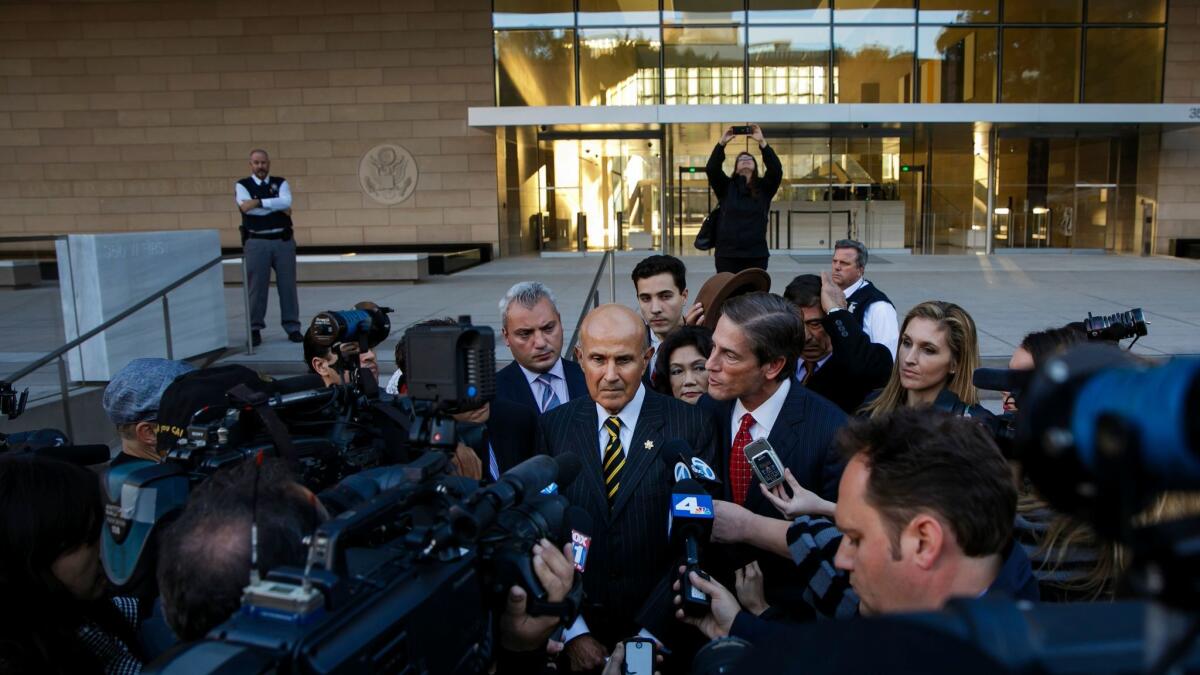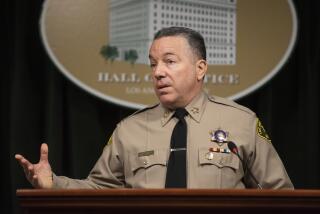Lee Baca in court, Round 2: What will sound familiar in the retrial, and what will be new

The first time Lee Baca was put on trial for obstruction of an FBI investigation, lawyers for the former Los Angeles County sheriff nearly convinced a jury that the government’s case was all smoke and no fire.
Now, with a retrial set to open this week, Baca’s defense team is ready to mount another defense, but this time under even more daunting odds.
All but one of the 12 jurors in Baca’s first trial in December voted to acquit him of charges alleging he was involved in a 2011 scheme carried out by subordinates to thwart a federal probe into widespread abuses and corruption by deputies working in county jails.
While it was clear that people below Baca had acted inappropriately, prosecutors failed to prove the then-sheriff had played a role, jurors said afterward.
The unyielding juror who believed Baca was guilty forced the judge to declare a mistrial. Despite the lopsided result, the U.S. attorney’s office quickly announced plans to try Baca again.
Jury selection in the second trial began Wednesday. Opening statements are expected later this week or early next week.
Broadly speaking, the retrial is expected to mirror the first, with the government relying on testimony from some of the subordinates involved in the obstruction conspiracy, other witnesses as well as phone and email records to make its case that Baca helped concoct and carry out the plan to obstruct the FBI probe.
In turn, Nathan Hochman, Baca’s lead attorney, is expected to once again portray Baca as an ethical leader who, although angered by the FBI’s efforts to investigate his jails, did nothing illegal. In the first trial, Hochman also hammered on the lack of hard evidence tying Baca to the obstruction — a strategy he is likely to follow once more.
But there will be differences the second time around.
Most notably, along with the charges of obstruction of justice and conspiracy from the first trial, Baca this time will face allegations that he made false statements to investigators about his knowledge and involvement in the obstruction plan during a 2013 interview.
Previously, U.S. District Judge Percy Anderson had decided to split the false statement charge from the others and planned to hold a second trial. He did so because a psychiatrist was expected to testify for Baca that the alleged false statements may have been the result of the early stages of Alzheimer’s disease. That testimony, Anderson said, could unfairly bias jurors when they decided whether Baca was guilty of the other charges.
But, at the urging of Assistant U.S. Atty. Brandon Fox, Anderson rejoined the three charges for the retrial. And, in a ruling late last week, he granted Fox’s request to bar the psychiatrist from testifying, saying the Alzheimer’s claims were speculative and could mislead the jury.
The moves by Fox were part of a larger attempt by the public corruption prosecutor “to hit the reset button” in the second trial, said Miriam Krinsky, a former federal prosecutor who led a commission on violence in the county jails.
Adding back the false statement charge will allow Fox to argue to jurors that the former sheriff lied to investigators in order to cover up his involvement in the earlier obstruction — an attack not available to him in the first trial.
In addition, Fox won a series of pretrial motions that will make it more difficult for Hochman to reprise his portrayal of the 74-year-old Baca as an upstanding public servant who was unaware of the misconduct carried out below him, according to Krinsky.
“It is an attempt to remove the cloak of credibility the former sheriff tried to wrap himself in,” Krinsky said.
Among other actions, Anderson ruled that Hochman cannot once again elicit testimony from witnesses about programs that were in place under Baca that addressed jail issues and oversight of the Sheriff’s Department. Baca has also been barred from wearing a lapel pin in the shape of the Sheriff’s Department star insignia.
Interested in the stories shaping California? Sign up for the free Essential California newsletter »
The allegations against Baca focus on a six-week period during August and September in 2011, after deputies discovered a phone that had been smuggled to an inmate who was working as an FBI informant. The inmate had been feeding agents information as they investigated allegations that sheriff’s deputies beat inmates and received bribes to sneak in contraband.
In the first trial, Fox told jurors it was at the sheriff’s direction that a group of deputies and commanders conspired to keep the inmate informant from his FBI handlers, tried to keep the inmate and deputies from testifying before a grand jury, and threatened and intimidated an FBI agent at her home to get federal investigators to back off.
In selecting a jury, Anderson and the attorneys will have to weed out people who are aware of a deal Baca struck with prosecutors in which he agreed to plead guilty to lying to investigators. In exchange, the government would forgo the more serious obstruction charges.
The deal, which called for Baca to serve no more than six months in prison, fell apart when Anderson decided it was too lenient. Instead of allowing the judge, who handed down stiff sentences to others convicted in the obstruction case, to decide on a punishment, Baca opted to take his chances at trial.
Follow @joelrubin on Twitter
ALSO
The story behind the mistrial in the Lee Baca corruption case
Witness in obstruction trial says former L.A. County sheriff was furious about FBI probe
U.S. attorney won’t file charges after probe of $1.3-billion iPads-for-all project in L.A. schools
Gang member accused of killing Whittier cop had cycled in and out of jail, records show
UPDATES:
4:50 p.m.: This article was updated with additional details about jury selection and opening statements.
This article was originally published at 4 a.m.
More to Read
Sign up for Essential California
The most important California stories and recommendations in your inbox every morning.
You may occasionally receive promotional content from the Los Angeles Times.











